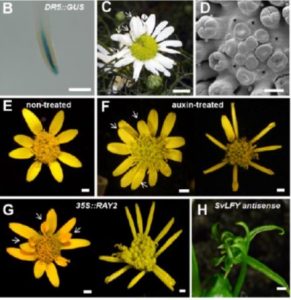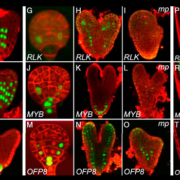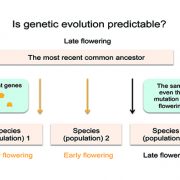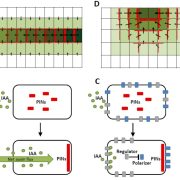Auxin Affects Capitulum Pattern Formation
 The flower head (capitulum) is a morphological feature that defines the family Asteraceae (the daisy or sunflower family). A typical capitulum consists of many flowers (florets) and phyllaries (modified bracts) compressed into a single structure that mimics a single flower. Capitula commonly have two types of florets: ray and disc florets. Disc florets are usually perfect flowers. In most cases, pattern formation of the capitulum is precisely controlled, with phyllaries (leafy bracts), ray florets, and disc florets positioned in a centripetal order in the capitulum, which mimic sepals, petals, and anthers, respectively. The formation of phyllaries and florets is typically asynchronous and acropetal (forming from the margin to center of the capitulum). Although the patterning mechanisms underlying the structure of capitula remain elusive, it has recently been reported that LEAFY (LFY), a key regulator of floral meristem identity, plays a role in capitulum development. lfy mutants make secondary inflorescences with cauline leaves instead of flowers in Arabidopsis (Arabidopsis thaliana). It has been also shown that the auxin pathway interacts with the LFY pathway, suggesting a possible role for auxin in controlling capitulum patterning. In Arabidopsis, auxin accumulation preceded LFY expression, and application of auxin onto inflorescences up-regulated LFY mRNA and protein. Auxin has been previously suggested to play a morphogen-like or a morphogenic trigger role in plant development. An auxin gradient was reported in several plant tissues such as the secondary vasculature, the female gamete, and the root tip. This suggests that auxin can provide positional cues for tissue specification in a concentration-dependent manner. Zoulias et al. (10.1104/pp.18.01119) now show that auxin provides a developmental patterning cue for the capitulum of Matricaria inodora. During capitulum development, a temporal auxin gradient occurs, regulating the formation of distinct florets and phyllaries. Auxin also regulates floral meristem identity genes, such as Matricaria inodora RAY2 and LEAFY, which determine floret and phyllary identity. This study suggests that hormone gradients, are important in development and have evolved independently in plants and animals.
The flower head (capitulum) is a morphological feature that defines the family Asteraceae (the daisy or sunflower family). A typical capitulum consists of many flowers (florets) and phyllaries (modified bracts) compressed into a single structure that mimics a single flower. Capitula commonly have two types of florets: ray and disc florets. Disc florets are usually perfect flowers. In most cases, pattern formation of the capitulum is precisely controlled, with phyllaries (leafy bracts), ray florets, and disc florets positioned in a centripetal order in the capitulum, which mimic sepals, petals, and anthers, respectively. The formation of phyllaries and florets is typically asynchronous and acropetal (forming from the margin to center of the capitulum). Although the patterning mechanisms underlying the structure of capitula remain elusive, it has recently been reported that LEAFY (LFY), a key regulator of floral meristem identity, plays a role in capitulum development. lfy mutants make secondary inflorescences with cauline leaves instead of flowers in Arabidopsis (Arabidopsis thaliana). It has been also shown that the auxin pathway interacts with the LFY pathway, suggesting a possible role for auxin in controlling capitulum patterning. In Arabidopsis, auxin accumulation preceded LFY expression, and application of auxin onto inflorescences up-regulated LFY mRNA and protein. Auxin has been previously suggested to play a morphogen-like or a morphogenic trigger role in plant development. An auxin gradient was reported in several plant tissues such as the secondary vasculature, the female gamete, and the root tip. This suggests that auxin can provide positional cues for tissue specification in a concentration-dependent manner. Zoulias et al. (10.1104/pp.18.01119) now show that auxin provides a developmental patterning cue for the capitulum of Matricaria inodora. During capitulum development, a temporal auxin gradient occurs, regulating the formation of distinct florets and phyllaries. Auxin also regulates floral meristem identity genes, such as Matricaria inodora RAY2 and LEAFY, which determine floret and phyllary identity. This study suggests that hormone gradients, are important in development and have evolved independently in plants and animals.









